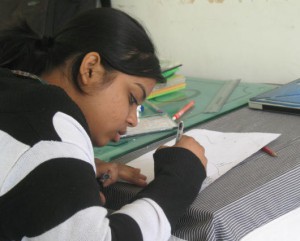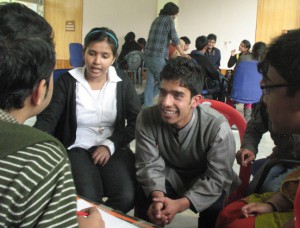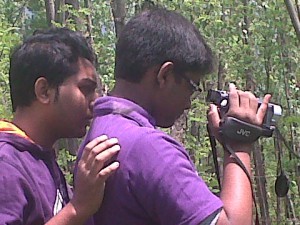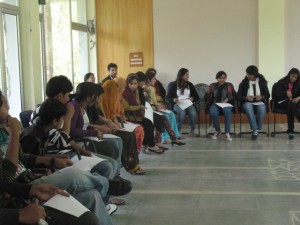It was 2010 when we first started planning the Kashmir project. However going to Kashmir and working with the youth there seemed like a distant dream. It took time and a lot of perseverance but we made it happen. On 19 april 2012, a group of 14 students from Laksmipat Singhania Academy, two teachers and two PeaceWorks representatives left for Srinagar to live and work with 14 students from Shehjar, a home for orphans run by the Help Foundation (J&K) in a village called Indrahama, a few kilometres away from Srinagar.
An escape into ‘Jannat’, away from the heat in Kolkata was something we had been looking forward to, notwithstanding our doubts and apprehensions about the place where we were to live for the next ten days. All doubts disappeared as soon as we were greeted by the thirty young adults who call Shehjar their home. The warmth and hospitality we received made us feel completely at home.
Not only Shehjar but all those we came across astonished us with their warmth and hospitality. On our morning-walks everyday we met a lot of strangers on the way who asked us where we were from and often, after a small chat invited us to their home for a cup of tea. Their smiling faces asking ‘kaise ho aap’, the pleasure of walking down roads, lanes and by-lanes, soaking in the stunning natural beauty of the surroundings without a sense of fear is a ‘real’ aspect of Kashmir that we wish others could also experience.
It was this warm, friendly atmosphere that made the ten days fly by. The group from Kolkata got along well with the group from Kashmir though the Kashmiri girls took some time to open up—they would usually stay huddled together, only talking amongst themselves. We wondered initially whether their inability to trust ‘outsiders’ stemmed from the atrocities that have been part of the valley’s recent history—which, of course, completely contradicted our experiences with the strangers on the streets! It seemed as if these girls, who were a little younger than those from Calcutta, were away from their homes for the first time. But as the workshop, they transformed gradually, bonding with everyone and making valuable contributions to the entire process. We hope they continue to get the opportunity to meet and interact with diverse groups of people. One of the girls, Zahida, seemed traumatized. But we refrained from asking her any difficult personal questions that we instinctively wanted to ask. Slowly, we found her seeking us out for long conversations. It was gratifying to see someone who found it difficult to say two words, willingly share her thoughts, feelings, desires, aspirations with us and above all even showing great curiosity about our lives and families in Kolkata.
The first evening at Shehjar was spent settling down, playing ice-breaking games so that we could get to know one another and prepare for the hard work that was ahead of us.Abeer Gupta, anthropologist and filmmaker, arrived at 9.30 sharp the next morning to commence the filmmaking workshop, that we had planned, with the aim of producing short films on themes of migration, social inclusion and diversity. These are set to be sent the United Nations Plural+ Annual Youth Film Festival.
Over the next eight days, Abeer worked for long hours with the participants. The first few days were spent intensely exploring various aspects of storytelling. He began by asking each participant to narrate a story about an interesting character. Then they had to introduce themselves with a story. Next, they were asked to pair up and narrate any interesting incident from their lives to know one another better. This, Abeer said, was very important for successful teamwork. The stories became more and more interesting and animated as we moved from anecdotes to personal experiences. The participants grew visibly more confident with each narration. We concluded the intense day of storytelling with a visit to the famed Shalimar Mughal Gardens.
The next day, the morning session was conducted at the Tulip Gardens. Though getting the participants to focus and concentrate in the beautiful outdoor setting was initially difficult, eventually the task set for the day caught their imagination and we had a fruitful morning. They were asked to draw a space in which they were most comfortable. Then they had to talk about the space and narrate a story centred round it—a wonderful exercise that provided a window into one another’s world and brought the participants closer. This exercise also showed the stark difference between the lives and backgrounds of the students from Calcutta and Kashmir.
Ishfaq, a kahsmiri boy, drew the picture of his house with a tree near it. While talking about his picture, he said that the tree was his enemy because when he was very young, his father had climbed the tree to pick walnuts, had fallen down on a wooden plank below with nails on it and had died. The students from Calcutta drew pictures of their room, which had everything in it from the latest gadgets, umpteen teddy bears even a jacuzzi in the bathroom. Naveed and Sohail from Shehjar and the two Shabnams from Kupwara drew pictures of their kitchen, which showed that they spent a lot of time there working or perhaps it was the warmest place in the house. Mudassir, from Shehjar, drew a picture of his classroom because he dearly misses his teacher.
From imaginary tales to real-life stories, Abeer continued the storytelling sessions for one more day to explain in depth the concepts of characterization, linear sequence of events, plot, capturing on celluloid what the eye sees and what the mind imagines. ‘To write an engaging script you first need to be a very good storyteller,’ he said.
Next came storyboards. ‘You have a story to tell, and you have only two minutes to tell it. How are you going to do this?’ he asked. After explaining the basics of long shot, mid shot, close-ups, etc. he asked the participants to translate their stories into drawings on paper in a frame-by-frame sequence. This exercise very clearly demonstrated that all of them actually had a magnum opus, which would be impossible to narrate in two minutes. So back they went to rewrite the stories on paper. ‘Focus on the plot and cut out all sequences that you can do without,’ Abeer advised. Much to our delight, all of them seemed to have an inherent flair for this and showed a keen interest. Soon, we had storyboards that told amazing stories in less than twenty frames.
Thinking that the participants needed a break after long hours of hard work we scheduled a day trip to Sonmarg for sunday. The extreme cold and drizzle did nothing to dampen our spirits on the spectacular drive to Sonmarg. It was a much-needed outing that rejuvenated the group and prepared them for the serious business of filmmaking the following day.
It was now time to decide the themes for the films. The day began with discussions on issues of migration, diversity and social inclusion. Diverse views were put forth and explored. Soon the discussion took the form of a healthy debate, which in turn became the foundation for developing story ideas for the films. The participants were divided into four groups of seven each, maintaining a balance between Calcutta and Kashmir. Intense brainstorming led to dozens of story ideas and after many rejections and modifications four were finalized. Work on the storyboards began again. By then, all the participants were well versed with the art of putting their ideas into film frames and soon we had rather professional storyboards.
To explore forms of films, Abeer introduced animation and showed us few very simple ways of making animated films. He also demonstrated pixilation—a simple process of clicking a series of still images to create the effect of motion. Megha and Raghav’s group decided to use animation for their films, Kaustav’s group decided on outdoor shoot and Kanishk’s group settled for pixilation.
The animation films demanded an incredible amount of patience and drawing skill, which the Kashmiri girls possessed. Kaustav, who wants to make filmmaking a career did justice to the natural beauty of Kashmir by choosing the most appropriate and picturesque locations for his group’s film. Kanishk’s group struggled for a long time and faced many rejections. The theme of their film came across strong but there was something missing. At one point it seemed as if they would give up but with a little push and encouragement, they persisted and eventually turned out winners. At the final presentation, it was their film that drew the most resounding applause.
It was time to part. A wonderful workshop with highs and lows, laughter and tears was coming to an end. It was highly successful. Strong bonds were made and lessons learnt for life—on handling rejection, on cultural sensitivity, on learning to adapt to completely different circumstances, on teamwork, on slowing down and lending a hand to others, on respect. We hope that these ten days will be etched in the memories of all the participants and they will draw strength from these memories in all walks of life in future.
As far as we are concerned, the Dialogue for Peace interventions was extremely successful and enriching.
One of the issues we have been struggling with each time is sustainability. This group has been given a journal carefully compiled with reading material and exercises on migration, which they have to complete in three months and send back to us. They have also been asked to record oral histories of migration in their family or among their friends and neighbours. We now look forward to receiving the wealth that will enrich these journals.




